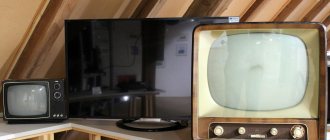At the end of the last century, the UN finally proclaimed World Television Day. Now every year on November 21, media workers, journalists and everyone who has anything to do with this field of activity celebrate their professional holiday. Television Day is a holiday not only for journalists, but also for ordinary television viewers.
2021 marked the twentieth Television Day. It was widely celebrated all over the world, because today it is almost impossible to find any state that does not have television broadcasting on its territory. It has already become one of the most effective means of influencing a person in modern society. Today there are more than one generation of people living in the world who simply cannot imagine their life without TV.
History of the invention of television
Previously, one could only dream of transmitting images over long distances. There have been many attempts to create something similar to TV in the past, but only the German physicist Heinrich Hertz managed to make a truly valuable contribution to the creation of television. Then the Russian scientist Stoletov substantiated the possibility of obtaining an image through a cathode ray tube. This tube, in turn, was developed by another scientist. We are talking about the physicist from Germany K. Braun.
So who invented television? The very first television system was the invention of Paul Nipkow. This German engineer managed to develop such an unusual device back in 1884. It was his invention that laid the foundation for the creation of the device that today is called a television. Nipkov managed to create a disk that made it possible to convert images into electrical impulses. Disputes about who invented television and when are related to the complex technical design of televisions. In addition, many elements of modern television were invented by different people.
How the first TVs worked
Previously, we established that the basis for the creation of the first television was the Nipkow disk. We determined in which country TV devices first appeared, and also found out who initiated the launch of mass production of the invented device. Only the operating principle of mechanical televisions remained unattended. This is exactly what we will talk about now.
To understand how a mechanical TV looked and worked, you need to understand the operating principle of a Nipkow disk. This is a rotating opaque disk. The diameter of the figure is no more than 50 centimeters. There are holes along the Archimedes spiral. Sometimes this disk is also called an electric telescope.
The light beam scanned the image. Subsequently, the television signal was transmitted to a special converter. One photocell was sufficient for scanning. How many holes were there? There are devices with different numbers of holes. Sometimes their number reached 200 pieces.
The whole process was carried out in reverse order. To display the image on the screen, engineers used a Nipkow disk. Behind the holes was a neon lamp. Thus, the image was projected onto a television screen. The speed was sufficient, but the picture was transmitted line by line. The person could see the image.
The first mechanical televisions can also be called projection televisions. The picture quality was poor. Only silhouettes could be seen on the screen. The Nipkow disk became the basis of these devices. Used before the advent of the first CRT televisions.
Principles of television operation in the 20th century
In the Soviet Union, full-fledged TV appeared already in 1939. The very first television receiver in the USSR worked on a Nipkov disk. It boasted a screen with a diagonal of 3 by 4 cm. The television receiver was produced in Leningrad and looked like an ordinary set-top box. In order to use the device, it was necessary to connect this set-top box to a radio channel.
Moreover, the then famous Soviet magazine about technology and science “Radifront” published a unique instruction that allowed anyone to make a TV on their own. Getting components for a new TV was not so easy, but many were ready to do anything to become the proud owner of a TV.
Who invented the first mechanical television
How did TV come about? The history of the creation of such a miracle of technology is long and not simple. The invention of the television would have been impossible without the following discoveries:
- 1817: Selenium is introduced, which helps in the production of electricity.
- 1839: First experiment with the use of selenium, which subsequently led to the creation of television.
- 1856: Thanks to the Heusler inertia-free tube, it was possible to convert electricity into light.
- 1875: The prototype of the first television was created, invented by George Carey. A little later, Porfiry Bakhmetyev created a telephotograph.
- 1884: German inventor Paul Nipkow introduced the Nipkow disk to the world - a device capable of scanning an image along the arrows and then transmitting it to the screen.
- 1889: Stoletov invented the photocell, a device that converts photons into electricity.
- 1895: The world's first kinescope, created by Karl Brown, appeared.
- 1907: a device appeared that could display a single picture from dots and shapes. Creator: Boris Rosing.
So who invented the first television? The efforts of the above individuals helped John Baird achieve real success. The very first mechanical TV in the world appeared in 1925.
Achieving this was not easy: the inventor of the television almost died because of his own device. During one of his experiments, Baird was nearly killed by high voltage. Like most inventions, the mechanical device was not well received by the public, but that soon changed.
Who invented color television
There were many attempts to convey a color image, but only Hovhannes Adamyan achieved success. Several decades of persistent research were not in vain. In 1908, he managed to obtain a patent for his invention.
Despite this, John Brad became the recognized creator of color television. He was also the inventor of the mechanical receiver. In 1928, he managed to assemble a device that could transmit images in red, blue and green.
The biggest breakthrough in the development of TV occurred after the end of World War II in the United States. It was during these years that television production appeared throughout the country. After American industry switched from civilian to military production, it made invaluable contributions to the development of the television industry. Already in 1940, a system called Triniscope was introduced.
When did he appear in the USSR?
In 1931, the first television broadcast was carried out in the USSR. Around the same time, the magazine Radiofront began publishing television diagrams for self-assembly. Nipkow discs, which were freely available, were connected to neon lamps. Later, radio receivers were connected to them to provide sound. It is noteworthy that at the time of the first television broadcast, televisions were not produced.
The beginning of mass production of televisions on a large scale is considered to be 1939. Serial production was undertaken by Leningradsky. The first such devices only vaguely resembled real analogues. They were radios with a knob and a small screen. The latter was 3x4 cm in size, and the device itself had to be connected to a radio receiver. Sound and image were broadcast separately from each other. Television programs began airing around the same time. They were broadcast by only one channel - “First”. He temporarily interrupted his work during the Second World War, but then resumed it and is still broadcasting. After this period, another channel also began to go on air.
In the USSR, in the period from 1946 to 1949, several engineers (Kenigson, Varshavsky, Nikolaevsky) invented the T-1 television. Its other name is KVN-49. The device received its name in honor of the first letters of the names of the inventors, and “49” is the date (year) of the beginning of its mass production. It became a truly “people's TV” because it was actively produced and sold. It gained notoriety - often its abbreviation stood for “Bought - Turned on - Doesn’t work” due to the fact that almost every second device had to be repaired before the end of the warranty period.
It looked like a wooden box with a small screen. The screen dimensions were 10.5x14 cm. The device weighed 29 kg. The model was produced with a lens that was used to enlarge the image. It was filled with glycerin or distilled water. Some of the models that survive to this day continue to operate, receiving broadcast signals.
From 1953 to 1955, a television was produced in the USSR, which was called “Rainbow”. It was equipped with an 18 cm kinescope. As it becomes clear, production quickly ended. This device was already much more like a modern TV.
Obviously, each of the listed devices broadcast only a black and white image.
History of television in Russia
In the Soviet Union, a lot of time and attention was devoted to the development of television, because TV was one of the key mouthpieces of propaganda for the Communist Party. Color television appeared in the USSR somewhat later than in the USA. In the USSR, a similar device was created only in 1951, so it was only in 1952 that Soviet viewers saw the very first test color television broadcast.
The first color TV in the USSR
The history of domestic TV goes back many decades. From the very beginning of its appearance, it gained truly popular popularity. Whole families gathered behind the screen of the miracle device.
You may be interested in: What does an HDMI cable look like?
In 1951, the Central Television Studio was organized. After this, the first thematic programs began to appear:
- Musical.
- Children's.
- Literary and dramatic.
During these years, the programs were broadcast only live. Then a new broadcast format appeared. Films, socio-political programs, reports, and concerts began to appear on television more and more often. Then young and talented journalists and announcers came to the Central Studio, whose names are inscribed in the history of national television in golden letters: Nina Kondratova, Igor Kirillov, Nonna Bodrova, Yuri Fokin, Damir Belov.
Announcers have made television a full-fledged means of communication. Many viewers even responded to their greetings before the news broadcast. In 1968, the “Time” program appeared, which is still the main information program of the country. Soon television became color.
New technologies of Soviet television
Television continued its rapid development and already in 1959 satellite television appeared in the country. The picture quality has constantly improved. In recent years, many countries have switched to digital broadcasting. It allows you to watch TV shows in the highest quality possible.
How old is television?
So how old is television? To answer the question of how old television is, you need to study history. The first transmission of a moving image was made in 1923. This was done in the USA. It is from this time that the history of television can be counted. It turns out that today television is already 95 years old.
Television Workers Day is celebrated on November 21st both in Russia and in other countries of the world. November 21st is considered International Television Day.
Interesting Facts
The creation of television was accompanied by a lot of interesting events. This applies not only to the history of world television, but also to domestic television. For example, the project for the famous Ostankino TV tower was invented just overnight.
- The very first 24-hour broadcasting channel is the American CNN. The company broadcasts not only in English, but also in other languages (German, Spanish and Turkish).
- The tallest television tower is located in Japan. Its height is 634 meters.
- Today, television advertising has become commonplace, but in the past it was something completely unique. Paid advertising appeared back in 1941. In those years, a ten-second video cost the customer $9. It was an advertisement for a watch manufacturing company.
- The most famous TV commercial is about the Macintosh computer. The author of the video is famous Hollywood director Ridley Scott. The customer for the video was Apple. This video cost $900,000, which was a record at the time.
- When television was black and white, presenters wore green lipstick. The fact is that it stood out more during the transition of the image through various camera filters. The red lipstick looked too faded on TV viewers' screens.
You may be interested in: The correct antenna for receiving DVB T2 digital television at the dacha
First public displays
On May 9, 1907, the first television broadcast was shown. At the St. Petersburg Technological Institute, one of the scientists (Boris Rozgin) managed to display an image of four white lines on a black screen.
Already in the 30s, television became electronic. In 1938, the very first television center appeared in the country. Then there was a break in the history of domestic TV. The Great Patriotic War is to blame. The first television program was released only on the eve of Germany's surrender. This significant event took place on May 7, 1945. Already on December 15th, the television center began regular broadcasting. This was a great achievement for post-war Europe. The USSR was even ahead of France and Great Britain.
Electronic TV: who invented it?
The creator of the electronic TV took the best from the developments of Boris Rosing, Paul Nipkov and Karl Brown. The development of the Russian physicist Rosing was continued by his compatriot Vladimir Zvorykin. The inventor was forced to move to the USA, where in 1923 he developed, patented and brought electronics-based television to the masses.
The first electronic TV in the world was later modernized:
- Zvorykin came up with the iconoscope, and devices with it began to be mass produced.
- Already in 1927, television broadcasting was launched on a regular basis in the United States, and then Germany, France and other leading European countries followed this example.
- Initially, the image was transmitted using an optically deployed principle, but by the mid-1930s, television broadcasts were based on the electronic principle.
Who created the first TV with new broadcast features? The Germans became the pioneers. The Telefunken company released the first electronic television device in 1934.
A TV at that time cost an incredible amount of money - $445. At the current exchange rate, the buyer would have to pay $7,500. Other countries did not lag behind Germany. France, the Soviet Union, and the United States entered the technology production race. By the beginning of World War II, the USSR industry surpassed the Germans with an indicator of more than two thousand units of goods.
The structure of TVs from the 70s and 80s
Inside the case on the left there were a transformer, a settings block, a radio channel and a channel switch, and at the bottom there was a color block and a condenser block. On the right was installed the most dangerous and powerful part - a scanning unit with high-voltage lamps and a line transformer. The TV received the meter range. To receive decimeter channels, a set-top box was released that converted the channels into one of the meter ones. Later they released SKD blocks that existed until the mid-nineties, that is, almost twenty years.
The next step was the transition to transistors assembled from microcircuits. Lamps were no longer used. Televisions became smaller and smaller and more technologically advanced. Manufacturers now present a huge number of TVs of different sizes. The possibilities of television are growing every year - progress does not stand still.
The essence of the theory of color perception
The meaning of this theory was that when using a light filter (three colors), a multi-colored image of various shades is obtained. These colors - red, blue and green - are still used today.
Two disks were used to obtain the image. They rotated at different speeds parallel to each other. In the first disk, slits were made along the lines of the radius, that is, from the center to the edge, and in the second, slits were cut in the shape of a logarithmic spiral. The number of slits was a multiple of three.
When the slots on both disks intersected, a diamond-shaped hole was created, which acted as a spreading element as the disks rotated. To obtain an image signal, the slits were sequentially closed with light filters. They were purple, green and red. Using a selenium photocell, the light that leaked through the diamond-shaped hole was converted into an electrical signal. Between the visual projection of the transmitted image and the photocell in each time interval there was one hole, which was closed with a light filter of some color. At the moment when the hole went beyond the image frame, another hole was moved on the opposite side, which was shifted by a distance equal to the width of the slit. This hole was closed with another light filter of a different color.
The era of digital and smart television
Digital television was developed in the early 1990s, and by the end of the decade, digital broadcasting had become commonplace. Unlike earlier devices that used analog signals to transmit video and audio, digital television relies on transmitting video and audio using multiplied digital signals.
Digital television has its roots in the availability of high-performance, low-cost computers. Today, digital television is transmitted in high definition with a higher resolution and widescreen aspect ratio compared to analog television.
The massive acceptance of these devices in the early 2010s prompted a major manufacturer to release smart TVs - regular digital TVs with built-in Internet and interactive web 2.0 capabilities.
Smart TVs are expected to become more popular in the coming years. As of 2021, 70% of TVs sold worldwide are smart TVs.
Sources
- https://tv-vybor.ru/stati/114-istorija-izobretenija-televizora.html
- https://oldinvent.ru/kto-izobrel-televizor-sozdanie-pervo/
- https://tehnikaland.ru/krupnaya-byitovaya-tehnika/istoriya-televizora.html
- https://www.vseznaika.org/tehnika/kto-izobrel-pervyj-televizor/
- https://teleinside.ru/kto-izobrel-televizor/
- https://stroy-podskazka.ru/televizor/pervyj-v-mire/
- https://tv-vybor.ru/stati/288-istorija-sozdanija-televidenija.html
- https://new-science.ru/kto-izobrel-televidenie/
[collapse]
What models did Soviet buyers like?
The following models were popular in the USSR:
- Model B 2 1931. Production on a large scale continued from 1933 to 1936. The screen parameters were 16*12 mm. Initially, it was not an ordinary device, but a set-top box that was connected to a special radio operating in the medium wave range.
- At the end of the 30s, American technologies were also used in the USSR. Several models were tried to be created under US license. But they were not put into production because the war interfered.
- The legendary KVN-49 enjoyed special love among the people; it was in his honor that the most famous program was named. It was developed at the Leningrad Research Institute. It gained popularity thanks to its non-standard mounted lens that magnifies pictures.
- In 1957, they began to make equipment under the general name Ruby. The Rubin 102 device could demonstrate up to 12 TV channels. It provided connectors for tape devices. Rubin 714 became a popular model.
- Dawn 307 is known for even greater popularity. In total, 8 million models were sold. Black and white equipment has been produced since 1975.
- Other well-known options include Record 312.
- The Horizon TV has been produced at the radio equipment plant since the 80s, in the city of Minsk. Such a unit was a scarce commodity.
- The Electron plant offered excellent technology to consumers. In the 80s, Electron Ts 382 was produced on its territory, which was distinguished by excellent picture clarity, good technical performance and modern design.









